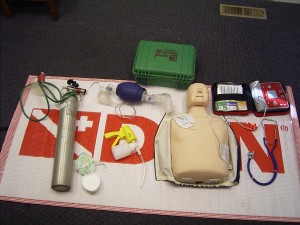It was another full day of seminars.
DAN-Physiological Aspects of Breath-hold diving
DAN-Medical issues in Closed Circuit Diving
DAN-PFO & the Risk of DCS
PADI-GoPro nights
DAN-Toxicological Aspects of Marine Life
DAN-Demystifying Hyperbaric Treatment of Divers
Breath-hold diving isn’t as benign as we might like to think. I’ve taught recreational skin diving and had a reasonable understanding of the hypoxia of ascent (sometimes called shallow-water blackout). The explanations in this seminar, though, really put it all together. The key points are: you can black out with ZERO warning, and even after ascending and taking a breath at the surface, you can still black-out. What does that mean? Have adequate support–a buddy or other support team that can come get you if you are in trouble. Have your buddy observe you after you are on the surface–remember, you can still black out after you hit the surface.
Closed-circuit: This is probably the most prolific new item at the show. Closed-circuit rebreathers, both for technical and recreational diving. That also means there are issues we need to start looking at. Rebreathers are not designed for rapid ascents and descents. They are complicated devices and they have to adjust your breathing gas mix as you dive. It’s possible for the gas mix to not have enough oxygen in it as you ascend, which could lead to hypoxia and loss-of-consciousness. Proper training and equipment maintenance are essential.
Break from the seminars to walk the floor… Lots of stuff to see, but as I mentioned above, rebreathers are the hot new toy this season. The good news is that we’ll probably see them drop in price so they’ll become more accessible for divers.
I spent some time at the DAN booth:
 Some cool new toys (soft-side O2 kits, First Aid Kits, O2+First Aid kits) and their business membership is evolving into their new Industry Partner Program. That will open it up to others in the diving world that aren’t just brick & mortar dive shops.
Some cool new toys (soft-side O2 kits, First Aid Kits, O2+First Aid kits) and their business membership is evolving into their new Industry Partner Program. That will open it up to others in the diving world that aren’t just brick & mortar dive shops.
I also hung out at the Project AWARE booth, talking to Ania and Jenny about how to better integrate Project AWARE into scuba programs and non-diving programs.

I’ve you’ve not already, please sign the Shark petition (right side of this page).
Back to the seminars…
PFO & DCS: Patent Foramen Ovale (PFO) is an opening between the sides of the heart that we all have as a fetus and for most of us eventually seals up by about age 2. It’s thought that PFO’s might predispose divers to having Decompression Sickness(DCS). Why, you might ask, is that? Well, about 20-30% of people continue to have this opening throughout their life and it has the potential for allowing bubbles to cross from the venous circulation to arterial, which might lead to serious neurological DCS if the bubbles head to the brain. The interesting thing is, while 20-30% of people have PFO’s, 40% of people with DCS seem to have them. The key thing here is, PFO’s don’t cause DCS–bubbles do! So, even if you have a PFO, if you can avoid bubble-producing dives (e.g., extreme dives), and dive conservatively, you could be fine. PFO’s have gotten a lot of diving-related press. From this seminar, I’d agree with the speaker–unless you’ve had multiple DCS hits that seem unreasonable for the dives, it’s not worth worrying about.
In order to get to the PADI GoPro seminar, I had to leave the PFO seminar a bit early. The PADI GoPro seminar was excellent. If you’ve never heard James Morgan from PADI speak, you’ll know why. If not, you’re missing out. James gave us a lot of incentive to have GoPro nights and while the events are targeted towards becoming a dive professional, that doesn’t mean we should solely talk to Rescue Divers and Divemasters. As dive professionals, we have the best job in the world. Others want our jobs. To get there, though, requires training. For dive shops, resorts and instructors–even if you’re not involved in creating Divemasters and Instructors–there is a lot to do to get those divers ready to become a Pro. All-in-all, this is a great thing for our industry.
Back to the DAN seminars…
Toxicological aspects of marine life injuries. Sounds pretty complex, right? In some respects, perhaps. The cool aspect, for me, was some of the explanations of why we treat certain injuries the way we do. Some injuries are incredibly painful–but not fatal. Some envenomations are painless, but carry a neurotoxin that can be lethal. For example, the Blue Ring Octopus. Painless bite, but the neurotoxin can be deadly. The toxin, though, primarily hits the respiratory system. That means that if recognized early, with adequate manual ventillations, a patient can make it to advanced care and survive. I could include a lot more, but taking a DAN Hazardous Marine Life Injuries course would be a better option. [Contact me!]
Demystifying Hyperbaric Treatment–this was pretty cool. After having completed my Diver Medic training and been in a chamber tending patients, this was an interesting presentation. Different types of chambers (multi-place and mono-place, aka many vs single patient), what they can & can’t do and how patients are treated were discussed. Treatment tables (how long, what depth, etc) were also covered. I think DAN has a webinar on this and I’ll see if we can run it at Dive Utah when I get back.
All-in-all, a great day and lots of info (and a stack of notes from the seminars). Time for a break from DEMA today with a trip to the Kennedy Space Center.




